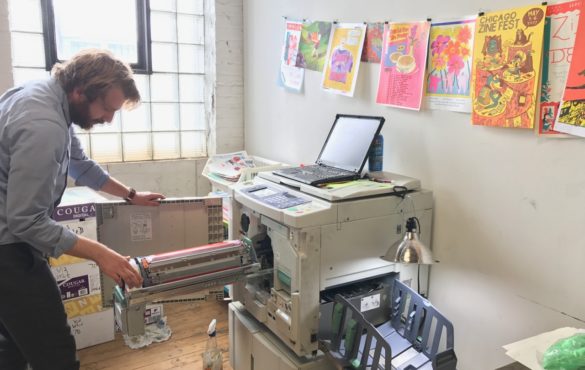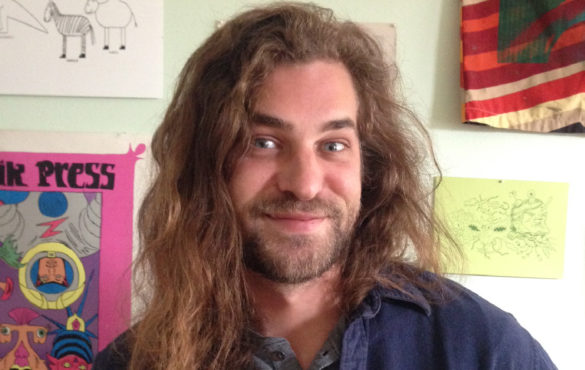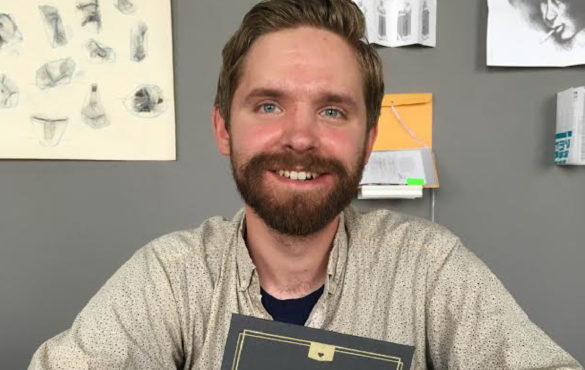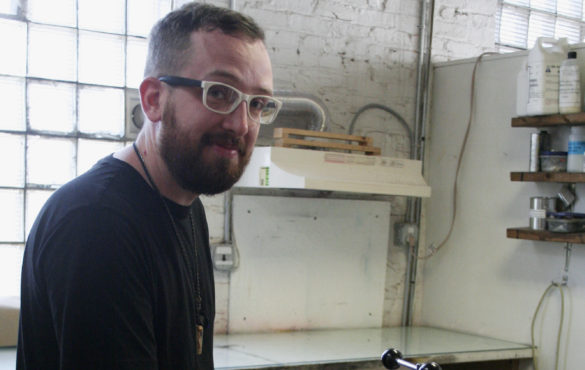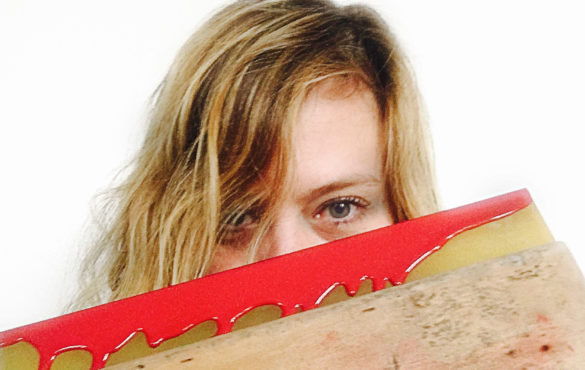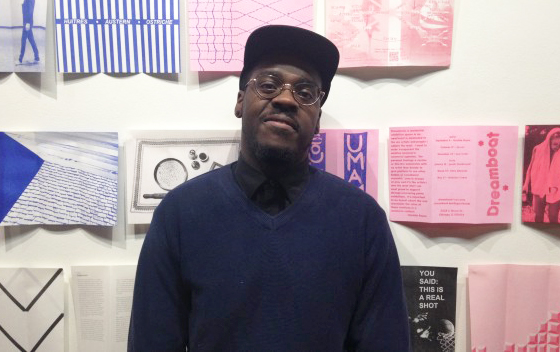On Election Day 2016, I sprinted up to the Press to meet with Spudnik Press member and cartoonist George Porteus. I had the opportunity to meet George when he was a guest artist at School of the Art Institute of Chicago, in Kaylee Wyatt’s class. George greeted me with a large smile and his long bouncy hair, saying he was more than happy to be here at Spudnik to be interviewed. Wearing his, as he calls it, “iconic Grimace purple jacket”, George also kindly complimented the modest comic I gave him upon our last meeting.
Former Maryland resident and MICA graduate, 32 year old George Porteus packed up his drawing supplies and moved to Chicago, Illinois four years ago. Upon sitting down in Spudnik’s Annex, he brought up how crazy it was that four years prior he was voting in the 2012 election. Although George was a practicing printmaker and cartoonist before moving, he attributes a lot of his success to the opportunity-filled midwestern city in which he now lives. Despite the fact he has had a rough few past months trying to get to the press to print, George has in the past year debuted Enter to Exit at CAKE 2016 and is currently involved with many collectives within the city such as Zine Not Dead and Trubble Club.

With an understanding of how financially, being an artist is always taking a risk, especially within publishing, George has a undeniable passion for making. Comics and self-publishing became his calling upon moving to Chicago. He credits Brain Frame performative comix reading for allowing him to be involved and truly understand how close knit we all are in Chicago.
Porteus: Brain Frame [was] place full of people where I felt where I belonged a little more than the outside world. My practice has been good ever since. It sorta oriented me in the right direction. Before that, artistically, I was um, I’ll say, unfocused with my efforts. I was drawing a lot but for no particular reason. So comics provided a really great context that requires very little, you know, prerequisite.
Howell: Totally!
Porteus: You don’t really need a degree. You don’t need anything more than a pen and paper and soon you wont even need that. Just an iPad pro or something like that.
Howell: What kinds of things are influencing your current body of work?

Porteus: Well, since starting to do comics in earnest maybe four years ago, I had a very fixed idea of narrative things I wanted to explore with comics. I have been honoring that, getting a little more ambitious each year with the lengths of the stories and how complicated or involved they are. And also the dialogue; the first few one-page narrative pieces I did for Lumpen [Magazine] were more or less one-sided so it was like a monologue, or silent, devoid of dialogue. [I have been] trying to improve my story telling abilities with a representational straightforward comic style. [This style of comics] interested me before starting to make comics myself. [Comics] where the story, um, does not alienate people. Like I think about the Simpsons. It’s a high bar to reach! Its funny, it goes down easy, but there is typically something a little more to it than that! The ability to appeal to a general audience and not alienate them, while still being subversive is kind of the magic trick. That is a though that I have had for a long time, since high school. Parallel to that is the practice I have observed within the comics community in Chicago. Comics work that [is trying] to bend everything I have just talked about as far as narrative art.
Howell: Your work speaks on behalf of a more highbrow art form in my opinion. You use beautiful techniques you don’t see often in comics now a day.

Porteus: Actually it’s interesting because, you’re right, you don’t see that these days so often, but the technique I use I completely ripped off from Her Block and political newspaper cartoonist predating World War II. Bill Mauldin who was a cartoonist for Stars and Stripes; you look back and it was all ink and crayon, which is all I use. It echoes the lithographic feel, which is something I was always into. It clicked to start using a crayon because I could better refine pieces but it’s still very much from the cartooning well. I was very excited. It opened up a lot to me. Prior to that I was a compulsive cross-hatcher, and it just took up too much time. I was going to get arthritis very soon. It didn’t excite people or myself. It was very easy to ruin a drawing by cross-hatching. The fact that it took twice the time to ruin a drawing by cross-hatching made it a easy decision [to use a crayon].
Howell: I’m aware you a member of Trubble Club, Lumpen, and have worked for Newcity, so how has being in publications around the city influenced your work?
Poretus: Trubble club was a great. I lucked out encountering them early on. I started publishing in a bi-monthly publication that ran for two years called Landline. I picked up the first issue while I was a Pilsen kid in the scene and noticed every artist and musician I knew was in it. The first issue had an open call so I submitted some work, and they rejected it. I added in my submission if they needed any editorial illustration work for articles I would like that opportunity. They gave me an article to illustrate and it was published in the second issue. Grant Reynolds was included in the issue. He was a great voice for getting me involved with Trubble Club. Also, my good friend Ben Marcus vouched for me and opened the door for me to get involved, not like its the mafia or anything, since you must be invited to join. I got to meet Joe Tallerico who edits the Lumpen comic section, and does a fantastic job, and that’s how I became apart of that. Aaron Renier put me in his Infinite Corpse project within meeting him twice. These are incredibly generous people with these types of opportunities. The first pager I did for Joe was the first comic I had published anywhere. It was a big deal for me. It felt good to see my work in print. The backend path of cartooning has always been the struggle. Everything that happens with the art when you’re done making it is an uphill battle. I have always been grateful and blown away to see my stuff in print, in a real newspaper, like Lumpen. Getting over the fear of putting something [in the public eye] that felt unfinished or less than what I thought it should be was paramount to moving on with my life and career. I’m thankful for everyone who has published me at this point. I have read that no matter how big you are, it’s nice if people can look at the progression of your work.
Howell: Let’s talk more about community. Spudnik is a big co-op where people come to create and there are tons of cartoonist that are actively involve. Do you feel a specific draw to working within these essentially collaborative environments?

Porteus: It was weird finding Brain Frame, walking into that room, because [collaboration] was not a need I had consciously recognized yet. I more or less put a premium on working in a bubble. Prior to that, I was not socializing with anyone doing anything related to what I was trying to do. In that way I never received useful or critical feedback. It was a vacuum. At that time I thought, “Oh I won’t be corrupted by other people or blended out by others style,” but I think now that was bullshit. I was rationalizing the position I was in. Once I found groups I could join, I was faced with the fact I couldn’t do anything without them. I really have benefited from people who are better at championing other sorts of art and other ways of working. Max Morris has just this massive comics library and private collection. He used to have parties where there was basically a giant pile of comics on the floor and we would spend a few hours talking, reading, and living comics. If you wanted to make comics, which was the absolute best place you could be. It was really easy to meet and talk to people that way. It’s a collegiate atmosphere and that is important! As much as you think, “I don’t need those things,” you absolutely do
Howell: Who are some printmakers who you are reading and looking at currently?
Porteus: A lot of local artist. Occasionally national artist will break through to me. As is in keeping with a lot of my other interest, I look into the past a lot for influence. Previously, I brought up Her Block. Newspaper cartoonists from between WWI and WWII also influence me, but also pre Comic Code and pulps stuff is a huge influence on me. I also really love jazz music and record covers, which is very cliché for comic artist these days. I’ve been looking at Blue Note record covers from the 70’s. I’ve been into things that have been flattening the cartoonist library and trying to mess with that so it’s no longer about conveyance, but something more. Local people like Jessica Campbell. She just released a new book…
Howell: I adore Jessica!
Porteus: Her work is always operating on many levels. Andy Burkholder remains a guy who I’m always impressed with, especially in terms of messing with vocabulary. That dissonance is what I’m very attracted to. The Zine Not Dead guys, Bred Press and Perfectly Acceptable. They are picking up the Brain Frame torch. You need to bring people together. It’s very important.
Howell: I feel like there is this missing step between people who make a living from comics and us. There is a dissonance I have been struggling with upon entering this world of comics. Everyone is very loving and open to give feedback, as long as said feedback is never negative towards the artist. Why is everything seemingly so unspoken?
Porteus: Both Chris Ware and Art Spiegelman are quick to say, “Oh I never expected to make a living off comics and I don’t recommend it” as they recoup many befits from having done what they say is completely impossible. Part of the nepotism within the upper crust of alternative comics is caused by the tiny patch of land that a lot people are fighting over. People are very nice while also extremely competitive. I remember fondly the second time I met Anya Davidson. She told me “I checked out your stuff,” and that was it. There was a conspicuous missing second part to that sentence, and that says she’s really good! I thought that was really cool. She’s not putting her opinion out there she will later regret. Now I’m hungry to impress Anya Davidson.
Howell: What is advice you would give to people just beginning to self-publish?
Porteus: Don’t be afraid to really put work out there, but always be honest with yourself about what you’re putting into it. It will always take more than it gives back, but most artists I know wear this as a point of pride. I’m all about self-righteousness. Work really hard! [laughs] Have that be enough. It won’t matter what happens externally because you will be proud of the work you have done. In my mind that is my fail-safe. At the same time, never be afraid to show people. I think the only way to improving visibly is by doing.
You can find George printing at Spudnik and selling work at Quimby’s, CAKE, and other various zine fest and comic events around the city.



 The Meaning of Life by Anja Wicki
The Meaning of Life by Anja Wicki